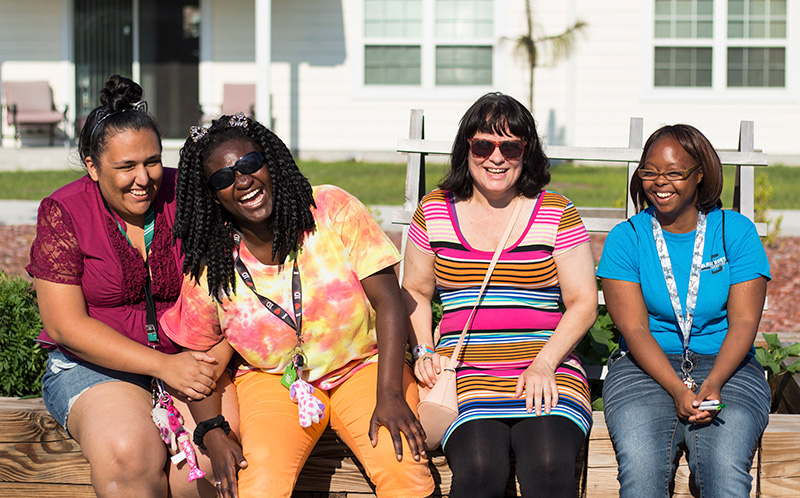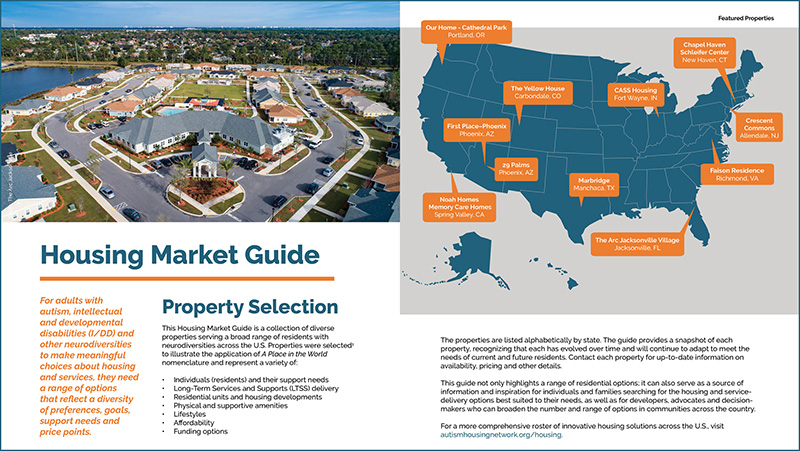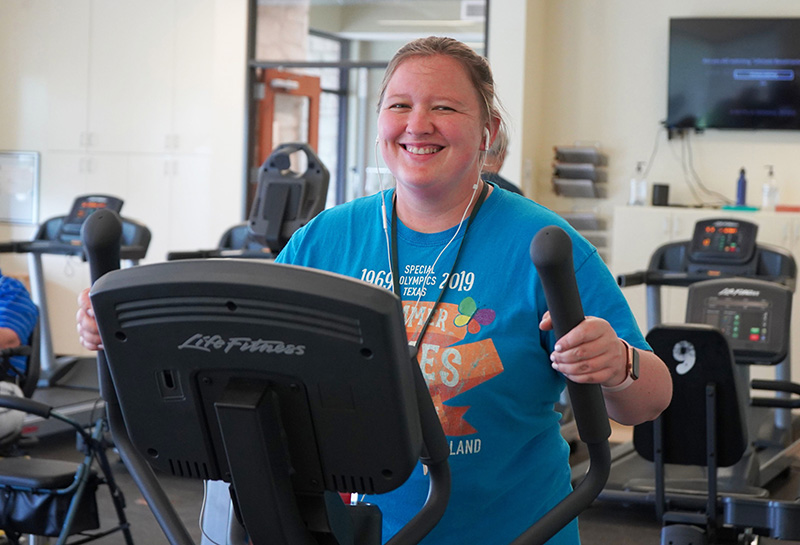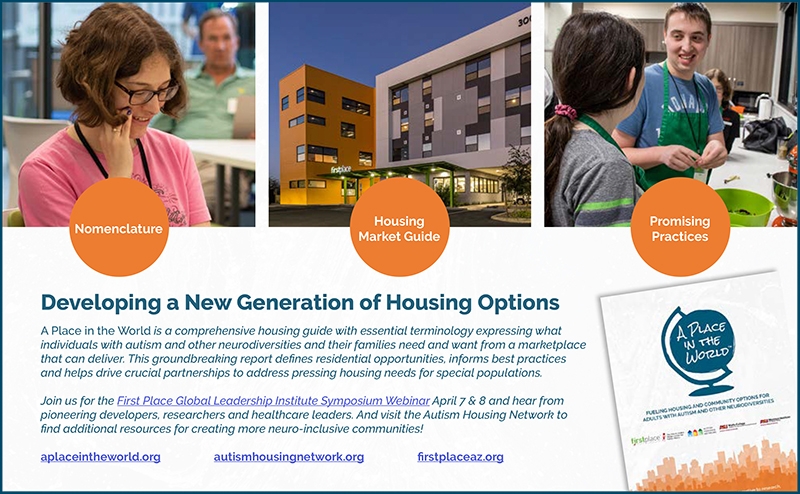Finding the right home for you or your loved one with autism or other intellectual and developmental disabilities (I/DD) can be daunting. While today’s marketplace is finally beginning to offer more options, several important issues should be considered to find the optimum housing environment once the momentous decision is made to move out of the family home. Individuals and their families can contemplate which of these and other options best fit their lifestyle interests, support needs, location preferences and finances.

Residents of The Arc Jacksonville Village, one of various national properties listed in the Housing Market Guide, enjoying new friendships
A great place to start is A Place in the World: Fueling Housing and Community Options for Adults with Autism and Other Neurodiversities. The 2020 report includes more than 150 terms and several examples designed to guide individuals and their families and developers alike. The first resource of its kind focused on supportive housing options, it aims to provide a consumer-friendly resource that advances a broad and more robust marketplace where individuals can better express their housing needs and preferences in terms understood by those prepared to deliver from the private, nonprofit, philanthropic and public sectors.
Co-authors include Arizona State University Watts College of Public Service and Community Solutions and its Morrison Institute for Public Policy, the First Place Global Leadership Institute and its Daniel Jordan Fiddle Foundation Center for Public Policy, Autism Housing Network, and pioneering leaders from all sectors across the U.S. and around the globe.
Just as home options for seniors have evolved and expanded over the past 50 years, individuals with autism and other I/DD should also be able to describe and access a variety of supportive housing choices offering a broad spectrum of services and amenities, diverse locational and lifestyle preferences and funding streams.
The five key issues shared in this article – and much more – can be explored in greater detail in A Place in the World. Consider the following as you build your vision of “home.”
1. Alignment with Life Goals and Lifestyle
When it comes to housing options, individuals and families may consider how their own lifestyle fits with a particular property or community. Whether it’s the ideal studio apartment or sharing a home with friends, a group home or a planned community setting, the type of property is the first step in determining where to live. For some, the energy and connectivity of urban life is convenient and empowering, while for others it can be overwhelming. Think about the type of location, home size, shared living opportunity and property type that foster overall well-being for you or those you serve.
Choosing where to live is also tied to desirable life goals. When exploring housing options, consider whether the lifestyle, supportive amenities, physical amenities, access to the broader community, including jobs, education, healthcare and more align.
Choices are also contingent on whether or how a long-term services and supports (LTSS) provider and LTSS delivery model coincide with desired experiences and outcomes. LTSS is the term for assistance with day-to-day tasks such as meal preparation, personal hygiene, housekeeping chores, social outings and general assistance inside and outside the home.
2. The Housing/Service Provider Connection
The ability for people with disabilities to live in a home of their own is largely dictated by the LTSS they can access in that home. Two main categories exist for how LTSS and housing may be related: provider-controlled and consumer-controlled.
In provider-controlled settings, the resident and LTSS provider are exclusively linked. The provider takes care of all housing details and cannot be changed. Residents pay rent or an all-inclusive fee to the service provider. If for some reason this provider can no longer support the resident as agreed, the resident must relocate. Examples of provider-controlled housing include traditional group homes, host family homes or tuition-based residential programs.
In consumer-controlled settings, there is no link between the residence and the LTSS provider; each resident chooses their own provider and can change them if needed and stay in their home. The resident is in control of and responsible for their home setting, including communication with the landlord and maintenance/repairs.
Although most consumer-controlled properties are rental units, there is growing demand for home-ownership options to avoid fluctuations in the rental market and bypass landlords. There is also a growing trend of consumer-controlled, planned communities with built-in amenities designed to serve individuals with autism or I/DD who choose their preferred LTSS provider. The property may also include unique supportive amenities, including various transportation options, a meal plan, organized life skill or social activities, or other cognitive-accessible features, to name a few.

A page out of the “A Place in the World’s Housing Market Guide,” a comprehensive resource featuring various properties around the country servicing a range of needs and preferences.
3. Support Needs
Deciding how services are delivered and by whom is an important step in the process. An individual’s level of support needed for personal wellness and community integration is strongly influenced by daily routines, frequency and nature of care, and those who support them. LTSS are covered out-of-pocket or through Medicaid. Support needs must be aligned with the LTSS delivery model and provider that best suit the individual’s needs. Some people may only need drop-in support, others may have moderate support needs and still others may require higher levels of support such as 1:1 support to help them navigate on a daily basis.
4. Physical and supportive amenities
Builders and housing providers are developing their properties in ever-diverse ways, with some offering abundant amenity packages attractive to the neurodiverse market. Consider the growing list of both physical and supportive amenities that extend beyond the property type and LTSS delivery model.
Physical amenities are built-in, residential features that can make life easier and more enjoyable. Common physical amenities range widely from sensory-friendly design and security features to smart-home technology and transit access. When considering housing, individuals and their families can match their life goals, interests, lifestyles and LTSS needs with the available physical amenities.

A resident of Marbridge in Manchaca, Texas enjoys a workout. Fitness centers are a key amenity for attracting prospective residents.
Supportive amenities are supports or features that are part of the property and benefit any and all residents; they are not individualized LTSS. Common supportive amenities range from community life and life-skills training to meal service and health and fitness activities. The cost of supportive amenities may be covered in rent or through out-of-pocket fees.
For some people on the autism spectrum who do not have an intellectual disability or may not be eligible for Medicaid-funded LTSS, these physical and supportive amenities can be the difference between homelessness and successful independent living.
5. Funding options
To live in a consumer-controlled setting, one must be able to afford rent. Affordable housing is very difficult to access. Families should begin planning for housing costs well in advance and, if needed and possible, apply to be put on the waitlist for housing assistance from the local Public Housing Authority.
Housing choices are largely determined by access to LTSS. Adequate Medicaid funding for someone with high support needs to live in a consumer-controlled setting is not available in most states. Advocacy efforts can change this! Individuals and their families must explore the different funding options (often called “waivers” that vary by state) and the reputation of the LTSS providers in their local area. Various funding sources are also listed in A Place in the World.
A new generation of supportive housing options are in demand and being delivered. The goal of A Place in the World is to fuel a robust marketplace while helping individuals and their families recognize that a diagnosis need not stand in the way of friends, jobs, supportive communities – and homes of their own.
Helpful Resources

Denise D. Resnik

Desiree Kameka Galloway
- A Place in the World: Fueling Housing and Community Options for Adults with Autism and Other Neurodiversities
- A Place in the World: Fueling Housing & Community Development for Neurodiverse Populations
- A Place in the World: Housing Market Guide Example, First Place AZ
Desiree Kameka Galloway is the director of the Autism Housing Network, a project of the Madison House Autism Foundation, and a sought-after disability housing expert. Denise D. Resnik is the parent of an adult with autism; founder, CEO and president of First Place AZ; and co-founder of the Southwest Autism Research & Resource Center (SARRC).





[…] Choosing the right neighbourhood is crucial when you have a child with autism. You will want to consider factors such as noise levels, proximity to parks or outdoor spaces and the general atmosphere of the community. […]